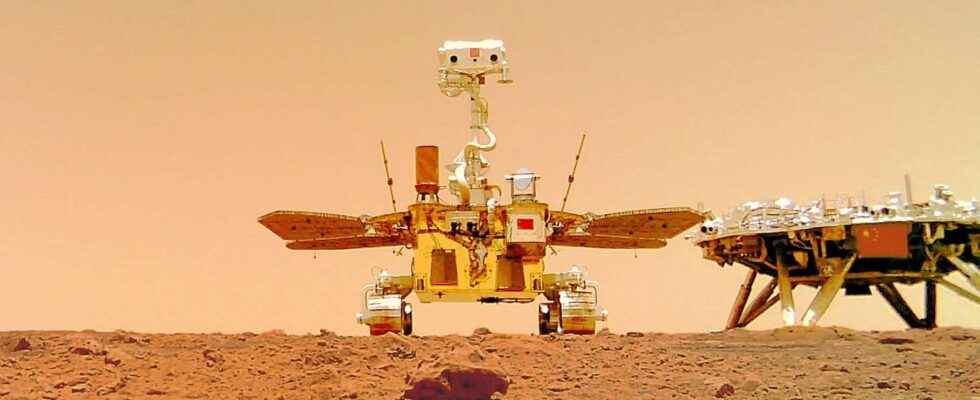A first communication and data transfer test was successfully carried out between the Chinese rover on the surface of Mars and the ESA Mars Express probe in orbit.
You will also be interested
[EN VIDÉO] Zhurong: his first sounds on Mars Zhurong is the first Chinese rover to set foot on Mars. And on June 27, 2021, the Chinese National Space Administration (CNSA) released a series of audio files that it recorded. A first ! It was May 22, 2021, when the rover was turning on its engines and descending the ramps of the lander to roll on the soil of the Red Planet. (Chinese translated into English) © CCTV Video News Agency
Currently, several rovers and scientific instruments are present on Martian soil. Likewise, eight probes now orbit continuously around the Red Planet. Their objectives: to collect as much data as possible to help scientists answer these fundamental questions: what is the geology of Mars, what was its history, what its landscape looked like in the past, was there liquid water, and has this planet welcomed life?
And information gathering is going well. On the front line, the rovers carry out measurements, of an extremely diverse nature, then transmit the data to their probe by orbit. This will then serve as a relay to transmit information to Earth. This is how the Chinese couple works of the Zhurong rover and the Tianwen-1 probe, controlled by CNSA, the Chinese National Space Agency. But, in an environment as vast and hostile as space, scientific collaboration between the different countries and more particularly the different space agencies, is necessary.
Blind communication between the Chinese rover and the Mars Express probe
Thus in November a series of communication tests between ESA Mars Express probe and the rover Zhurong. A successful operation on November 20, but it was not an easy task.
Indeed, the systems radio between the two instruments are not fully compatible. While Mars Express is able to receive communications from Zhurong, the reverse is not possible. Difficult in this configuration to establish a stable link between the rover and the probe in orbit. But never mind. On the orders of the Tianwen-1 probe, the rover pointed its radio antenna towards the sky and sent out a blind signal, successfully received by the Mars Express probe. A one-way conversation therefore began between two instruments associated with different missions. A first ! Zhurong was thus able to transmit data, which, relayed by Mars Express, arrived on Earth at the ESA operations center. The data was then transmitted to the teams controlling Zhurong in Beijing, who confirmed their good quality and the success of the operation.
The success of these tests is particularly encouraging for refining cooperation and communication between the various ongoing missions far from our Earth.
March: the large amount of data collected by the Chinese rover Zhurong is long overdue!
Arrived last May on the Red Planet, the Chinese rover Zhurong continues to collect new data on the surface and theatmosphere Of March. If the results look promising, they are however long awaited by the scientific community.
Article by Morgane Gillard published on December 1, 2021
Since last May, the Chinese rover Zhurong roams the Martian plain of Utopia Planitia, located in thenorthern hemisphere of the planet. Equipped with multiple instruments – including cameras, radar system, spectrometer laser and various sensors responsible for measuring the temperature, pressure or the strength of wind -, the robot keeps collecting new data on the weather and the geology of Mars. The information is transmitted regularly to Earth, where many Chinese teams are working to analyze it.
Results eagerly awaited by the scientific community
The results are therefore eagerly awaited by the scientific community. Because the rover landed in a still unexplored area of the Red Planet and its investigations could provide new data concerning the presence of water or ice under the Martian surface. Among the expected results, the possible presence of sedimentary rocks and elders volcanoes of mud are therefore of particular interest to planetologists around the world since they could signify the past existence of an ancient ocean.
To date, few data have however been transmitted to the scientific community, which is impatient to await these promising results. Two articles have so far been published in scientific journals. the first, based on the analysis of images and data of friction between Martian soil and the rover’s wheels, offers a first overview of the properties of the soil on which the robot. the second article analyzes images transmitted by the Tianwen-1 probe in orbit with the aim of precisely locate the rover on the surface of Mars. Interesting results but which leave the scientific community unsatisfied. While waiting for the publication of new results, Zhurong continues his exploration, which was not originally planned to only work 3 months.
Interested in what you just read?
.
fs3
